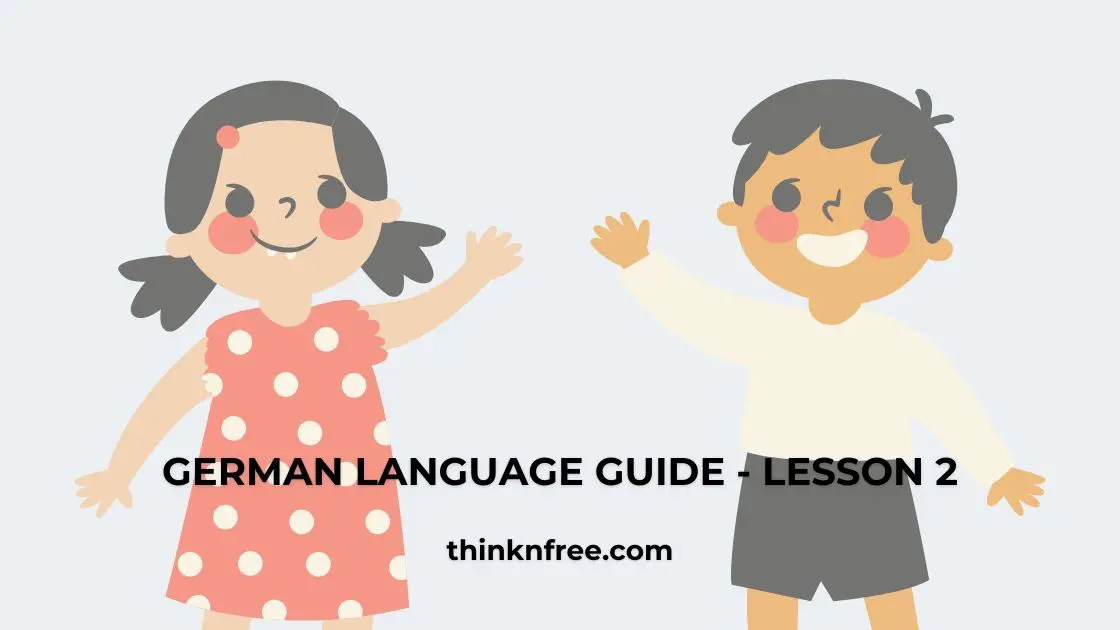Learning German Greetings, In the world of language and culture, greetings and essential phrases are the keys that unlock doors to meaningful interactions. When it comes to the German language, mastering these initial exchanges is not only a practical necessity but also a gesture of respect towards its rich linguistic heritage. In this article, we will embark on a journey to explore the heartwarming greetings and essential phrases that will pave the way to effective communication in German. Whether you’re planning a trip to Germany, connecting with native speakers, or simply indulging your passion for languages, these phrases are your trusty companions.
Previous Lesson: Your First Step to German Language Proficiency – Lesson 1
The Significance of Greetings
Greetings are more than just words; they are the bridges that connect individuals, cultures, and traditions. They serve as the cornerstone of human interaction and convey respect, warmth, and politeness. In the German Language, greetings are not merely obligatory niceties; they are genuine expressions of social courtesy. Let’s explore and begin with learning German greetings.
Related: Greeting
Starting with the Basics
As a beginner, it’s essential to start with the most fundamental German greetings. These are the building blocks of your language journey:
- Hallo: This versatile greeting is akin to the English “Hello.” It’s friendly and casual, making it perfect for both formal and informal settings.
- Guten Tag: “Guten Tag” means “Good day” and is a standard and polite way to greet someone. It’s a versatile greeting suitable for most situations.
- Guten Morgen: To say “Good morning,” use the German phrase “Guten Morgen.” The ideal way to begin the day.
- Guten Abend: Use the German phrase “Good evening” to welcome people as the day transitions into the evening. It establishes a civil and courteous tone for interactions at night.
The Importance of Time
In German culture, the time of day plays a crucial role in choosing the appropriate greeting. Using the right greeting at the right time demonstrates cultural awareness:
- Morgen, Vormittag, Nachmittag, and Abend: These words signify specific times of the day – morning, late morning, afternoon, and evening. Pair them with greetings for a more precise and polite interaction.
Asking about Well-being
Inquiring about someone’s well-being is a common courtesy in Germany. Two essential phrases to remember are:
- Wie geht es Ihnen?: This formal phrase means “How are you?” It’s a polite way to show concern for the other person’s well-being.
- Wie geht’s?: In more relaxed situations, you can use this shorter version of the previous phrase. It’s similar to asking “How’s it going?” in English.
The Art of Addressing Others
Addressing others appropriately is a significant aspect of German greetings. Understanding when to use “Sie” (formal) and “Du” (informal) is essential:
- Sie: Use “Sie” when addressing strangers, elders, or in professional settings. It conveys respect and formality.
- Du: “Du” is reserved for friends and informal relationships. It indicates a higher degree of familiarity.
Adding Formality with “Herr” and “Frau”
To elevate your greetings to a more formal level and show respect, incorporate “Herr” (Mr.) and “Frau” (Mrs. or Ms.) before the person’s last name. For example, “Herr Müller” or “Frau Schmidt” adds an extra layer of politeness and acknowledges the individual’s identity.
Essential Phrases for Everyday Conversations
In addition to basic greetings in German language, learning essential phrases for everyday conversations will enhance your ability to communicate effectively:
- Bitte: This versatile word means “please” and is used when making requests or expressing politeness.
- Danke: Say “Danke,” which is Deutsch for “Thank you,” to express thanks.
- Entschuldigung: This word is for “Excuse me” or “I’m sorry.” It ought should be employed to bring attention to oneself or convey remorse.
- Ja and Nein: “Ja” is for “Yes,” and “Nein” is for “No.” These are fundamental responses in any language.
Basic Introductions
Introductions are essential for initiating conversations and building connections:
- Ich heiße…: To introduce yourself, say “Ich heiße…” followed by your name. “Ich heiße Anna” for instance means “My name is Anna.”
- Wie heißt du?: “Wie heißt du?” (which translates to “What is your name?”) should be used to find out someone else’s name.
- Das ist…: To introduce someone else, say “Das ist…” followed by their name. For example, “Das ist Peter” means “This is Peter.”
Asking for Directions
When exploring a new place, asking for directions becomes crucial. Familiarize yourself with these phrases to help you navigate:
- Wo ist…?: To ask where something is located, use “Wo ist…” followed by the location. For example, “Wo ist der Bahnhof?” means “Where is the train station?”
- Links and Rechts: “Links” means “left,” and “Rechts” means “right.” These directional words are indispensable for following directions and finding your way around.
Ordering Food and Drinks
Dining is a delightful way to immerse yourself in the culture, and ordering in German restaurants can be a pleasant experience:
- Die Speisekarte: When you’re ready to order, ask for “Die Speisekarte,” which is the menu.
- Ich möchte…: To place an order, say “Ich möchte…” followed by your choice. For example, “Ich möchte einen Kaffee” means “I would like a coffee.”
Saying Goodbye
Just as important as greetings are the ways to bid farewell:
- Auf Wiedersehen: The standard way to say “Goodbye” in a polite and formal manner. It translates to “Until we see each other again.”
- Tschüss: A friendly and casual way to say “Goodbye.” It’s suitable for informal settings.
- Bis später: Use “Bis später” to say “See you later” when you plan to meet someone again soon.
Expressing Gratitude
Gratitude is a universal language that transcends barriers. In German, there are various ways to express thanks:
- Vielen Dank: This means “Thank you very much” and conveys deep appreciation.
- Dankeschön: A slightly more informal way to say “Thank you.”
- Danke sehr: A polite way to express thanks, similar to “Thank you very much.”
The art of greeting in the German language is a fascinating journey of discovery, cultural immersion, and social connection. As you embrace these greetings and essential phrases, you not only unlock the doors to effective communication but also gain a deeper understanding of the culture and people you encounter. So, start your linguistic adventure with a warm “Hallo!” and explore the boundless opportunities that await in the world of the German language. Greetings are your passport to connection and cultural enrichment. That’s the story about learning German greetings, practice is the only way you can improve your language skills. So make sure to practice more and gain new skills. See you with another brand new lesson.
I’m an undergraduate and network engineer with a passion for learning new cultures and languages. I love connecting with people from different backgrounds and exploring diverse perspectives.


2 thoughts on “Learning German Greetings from the Ground Up – Lesson 2”